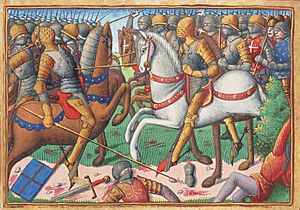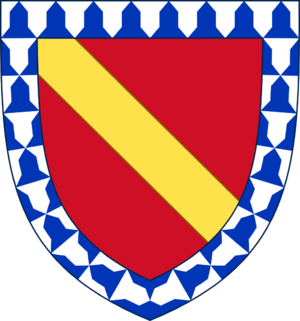Gilbert Motier de La Fayette facts for kids
Quick facts for kids
Gilbert Motier de La Fayette
|
|
|---|---|

Marshal of France Batons
|
|
| Other name(s) | Gilbert III de Lafayette |
| Born | 1380 Auvergne |
| Died | 22 February 1463 (aged 82) Auvergne |
| Buried |
Abbey of La Chaise-Dieu
(45°19′20″N 3°41′51″E / 45.32222°N 3.69750°E) |
| Allegiance | Kingdom of France |
| Years of service | 1409-1449 |
| Rank | Marshal of France |
| Battles/wars | Hundred Years War |
| Spouse(s) |
|
Gilbert Motier de La Fayette (1380 – 22 February 1463) was a French nobleman and a brave military leader. He was known as the Lord (or Seigneur) of several places like La Fayette and Pontgibaud. He became a Marshal of France, which was a very high military rank.
Gilbert Motier de La Fayette is also related to a famous American hero, Gilbert du Motier, Marquis de Lafayette, who helped America win its independence much later.
Contents
A Life of Service
Gilbert Motier de La Fayette was born in 1380. He grew up in the court of Louis II, Duke of Bourbon, learning about noble life and military skills.
Early Military Career
In 1409, Gilbert served as a soldier in Italy under the command of Marshal Boucicaut. After leaving Genoa, he returned to France. He then became a high-ranking official (called a Seneschal) in the region of Bourbonnais.
Fighting in the Hundred Years' War
During the long conflict known as the Hundred Years' War, Gilbert played a big part. In 1413, he fought alongside John I, Duke of Bourbon at Soubise. Two years later, in 1415, he was with the Duke of Bourbon again at Compiègne.
Gilbert was a skilled fighter and was promoted to the rank of lieutenant-general. He served in areas like Languedoc and Guyenne. He won important battles against the English and Burgundian forces in the Loire valley.
In 1420, Gilbert was given the important job of Governor of Dauphiné. He also became a Marshal of France, one of the highest military honors.
Major Battles
In 1422, Gilbert and John Stewart, Earl of Buchan led French and Scottish troops at the Battle of Baugé. This was a significant victory for France. However, in 1424, at the Battle of Verneuil, Gilbert was captured by the English. Luckily, he was released soon after.
A few years later, in 1429, Gilbert Motier de La Fayette joined forces with the famous Joan of Arc. He led 300 men to help lift the Siege of Orléans, a crucial moment in the war. He also fought bravely with Joan at the Battle of Patay.
Royal Advisor
On 17 July 1429, Gilbert was present at the coronation of King Charles VII in Reims. He became a member of the King's important council, called the Grand Conseil.
Even though he faced a brief period of disfavor around 1430, Gilbert remained a trusted advisor to King Charles VII for most of his life. In 1435, he was one of the people who signed the Treaty of Arras. This treaty helped bring peace between King Charles VII of France and Philip the Good of Burgundy.
Army Reforms and Later Campaigns
From 1445 to 1448, Gilbert helped make important changes to the French army. He worked to set up military outposts to stop bandits and keep the peace. In 1449, he also signed a treaty with Edmund Beaufort, 2nd Duke of Somerset.
In 1449, Gilbert fought for France in Normandy against the English. On 19 October 1449, he was there when the city of Rouen surrendered to the French.
Gilbert Motier de La Fayette passed away on 23 February 1463 in Auvergne. He was buried in the Abbey of La Chaise-Dieu. On his tombstone, you can see the word Merito, which is a clever rearrangement of the letters in his name.
Family Life
Gilbert Motier de La Fayette was the son of William Motier La Fayette, who was also a knight and soldier. His mother was Marguerite Catherine Brun du Peschin. Gilbert had a brother named Barthélemy and two sisters, Algaye and Gilberte.
Gilbert married twice. His first wife was Dauphine de Monteith, whom he married in 1420. After she passed away, he married Jeanne de Joyeuse in 1423. Jeanne and Gilbert had nine children together:
- Charles (1425–1486): He became the Lord of La Fayette. Charles was knighted during the siege of Rouen in 1449. He later became an advisor and chamberlain to the king.
- Antoine (1426–1480): He was also an advisor and chamberlain to King Louis XI. Antoine became a Captain of different strongholds.
- Françoise (born 1427): She married Jacques Fourrier.
- Jean (1430-1490): He became a Knight of St. John, a religious military order.
- Louis (born 1431): He became a priest (called a canon) and a Count in Lyon.
- Catherine (c.1432-1484): She married Hughes de Chauvigny. Their son, Raynard, became the Abbot of La Chaise-Dieu.
- Anne (born 1434): She married François de Maubec.
- Jeane (born 1435).
- Gilbert IV (1440–1527): He became the Lord of Saint-Romain. Gilbert served both Louis XI and Charles VIII of France. He later became the maître d'hotel (a high-ranking household official) for Charles VIII. His son, Antoine, became a knight and a Grand Master of Artillery.
Gilbert also had a daughter named Louise (died 1456). She married Jehan de La Roche. After Jehan died in battle, there was a dispute over the Château de Tournoël, a castle they owned. Eventually, the castle was given to Louise and her children.




